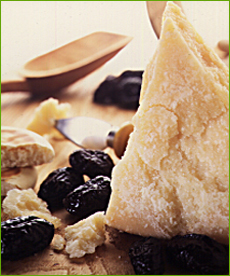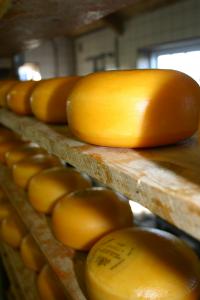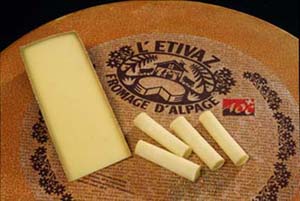

Parmigiano-Reggiano: aged and aromatic, but most delightfully so. Photo courtesy of the prugnedellacalifornia.it.
|
STEPHANIE ZONIS focuses on good foods and the people who produce them. Click here to contact her.
|
|
October 2005
|
 |
Whey To Go! ~ October 2005
On The Art Of Aging (Gracefully)
Click here for other months’ columns
My name is Stephanie Zonis, and welcome to Whey to Go! Every month, we delve into a new cheese-related subject, and I offer a recommendation on a cheese I love. This month it’s aged cheeses.
When I mentioned to a friend that I was writing an article on aged cheeses, she shuddered, adding that she couldn’t stand “strong, stinky, old cheeses.” Hold on, there! There are some very strong, sharp, er, particularly aromatic aged cheeses, but they’re not all like that, not by any means. Let’s take a look at the aging process for cheeses, which is a critical step in flavor development.
First off, what is an “aged” cheese? Cheeses are either fresh or aged. Fresh cheeses are generally mild and soft in texture; examples are ricotta, mozzarella, some chevres, and queso blanco. You recognize the type; they’re creamy and somewhat bland in flavor. Aged cheeses can range from semisoft to hard in consistency, and many are multi-textured, with a semisoft paste near the rind leading to a softer center. One of the great things about aged cheeses is their incredible range of flavors. Sure, some are the aforementioned “strong and stinky” varieties, but others are sweeter and less pungent, though beautifully complex. For instance, there’s Parmigiano-Reggiano, a cheese held in universally high esteem for its ability to complement so many other foods (it’s also great by itself). Authentic Parmigiano-Reggiano is aged for one to four years (most wheels age from eighteen months to two years). And yet this cheese is not “stinky.” It’s stronger in flavor than some others, true, but not overwhelming.
But this article isn’t meant to focus on Parmigiano (although some day I’ll write one that does). Before we discuss the delicious results of well-conducted aging, we need to go back in time to the point in the cheesemaking process when aging begins. Once the milk is heated and the starter is introduced, the resulting curds are cut and drained of their whey. After salting, the curds are placed into molds. The molds are pressed to extract more whey. Following this step, the cheeses are ready to begin their aging, a process that is as much art as it is science (that statement applies to many aspects of cheesemaking). The aging process is also known as ripening, maturing, or affinage, and it is sometimes overseen by a specialist in the field called an affineur.
Rind development is a decisive factor in proper aging, and cheesemakers work diligently to ensure their products will have the right sort of rind. Without a good rind, a cheese will lose too much moisture during aging (the exception to this are rindless cheeses, which are covered in a thin layer of wax and then aged; Gouda is an example of this type). Rind may also be important to a cheese’s ultimate flavor. There are three basic types of rind: natural, bloomy, and washed.
- A natural rind is one that develops on the exterior of the cheese through drying, without the addition of any “ripening agents” (such as mold) or washes. Most semi-firm or hard cheeses have natural rinds; these may be thin, as is often the case in bandaged Cheddars, or thick, as occurs with Parmigiano-Reggiano or Pecorino Romano.
- A bloomy rind is formed by spraying the exterior of a cheese with spores of Penicillium candidum, a harmless mold, prior to the start of the ripening process. This mold produces flavor in the cheese. Bloomy-rinded cheeses fall into the soft-ripened category; examples are Brie, Camembert, and some chevres.
- Washing the exterior of a cheese periodically with brine, oil, brandy, whey, beer, cider, or wine while the cheese ages produces, as you might expect, a washed-rind cheese. This washing keeps the rind moist, which encourages the growth of particular bacteria (again, these are harmless). Depending upon the cheese, the bacteria are scraped off, scraped off and turned back into the cheese, or left alone to promote further rind development. Examples in this category include Taleggio (often cited as one of the great cheeses of the world) and my favorite-named example of this type of cheese, Stinking Bishop. Stinking Bishop has it’s rind washed with perry, an alcoholic pear “cider”, and it is very strongly flavored.
The Art of Ripening
But how is ripening done? That depends upon the cheese and the cheesemaker. The three crucial components of aging are rind development (which we’ve already discussed), humidity, and temperature. Ripening cheeses need a lot of humidity in their environment, usually between 80 and 98 percent. Cheeses do lose moisture as they age, but a humid environment aids in preventing the loss of too much moisture too quickly and encourages bacteria to flourish, which helps with flavor development. Temperature is also extremely important. If an aging cave is too warm, the cheeses may spoil, ripen too quickly, or “sweat,” thereby losing moisture and butterfat. On the other hand, if the environment is too cold, the cheeses may not ripen at all, or they may take much longer to ripen than anticipated. The ideal temperature for maturing depends upon the type of cheese involved; I’ve read of aging temperatures that ranged from the low 40’s to the mid 60’s, in degrees Fahrenheit.
Historically, cheeses were ripened in naturally-occuring stone caves. The caves were dependably damp, as a rule, but some were subject to temperature swings that could drastically alter or even ruin the finished product. Besides, not everyone who makes cheese has a cave conveniently located in the neighborhood. The solution? Build your own. And that’s precisely what many modern cheesemakers do. Of course, the caves, or aging rooms, they construct aren’t necessarily made from stone (although some are); in at least one case I know of, a cellar beneath a manufacturing plant has been turned into an aging cave. Sizes of these caves vary considerably, depending upon production quantities. But as always, the important factors are the ability of the ripening facility to hold proper humidity and the correct temperature. In larger modern maturing facilities, these are often controlled by computer. |

Wheels of cheese ripening in a modern, temperature-controlled “cave.” |
Careful handling of aging cheeses is also important. The cheeses are “racked”—that is, placed on boards or shelves, then in racks. Traditionally, the boards were wooden, and some manufacturers still prefer to use wooden shelves; others have turned to plastic or metal. Cheeses are usually turned regularly to ensure uniform ripening. Some manufacturers start their aging process in a warm place for 24 to 48 hours to promote culture development before moving the cheeses to a cooler environment so they can age more slowly, thereby developing greater flavor. Cheeses may be wrapped in leaves, laid on beds of straw or mats made of rye, bound by thin spruce slats, or have tree boughs laid against their surfaces, all in the name of desired taste and aroma characteristics.
And for how long are cheeses aged? As has already been mentioned, Parmigiano-Reggiano can be aged for up to 4 years. Asiago is often aged for 2 years. At the other end of the spectrum, some aging periods range from mere days up to a number of months. Brillat-Savarin is ripe after just a week or two, while Colby ages for several months.
In general, cheeses aged for shorter amounts of time will be softer, creamier, and less strong in taste and aroma. Peak ripeness is judged by aroma, taste, texture, and even color. It takes skill and experience to determine optimum ripeness for any cheese, and yes, cheeses can become overripe. When that occurs, a cheese becomes unpleasantly pungent, with an ammonia smell and a flavor that’s overwhelmingly strong and acidic. (Is it possible that my shuddering friend had been given an overripe cheese at some point?) That’s why tasting a cheese is so important, and a good cheesemonger will always let you taste before you buy.
Everyone always asks if you can eat the cheese rind, and this is entirely dependent upon the cheese. Bloomy-rinded cheeses often have edible rinds; in fact, eating the rind helps you get the most flavor out of the cheese. Cheeses with natural rinds may or may not have rinds pleasant to eat, and rinds are not usually consumed in washed-rind cheeses. As you might suppose, the wax on the exterior of a rindless aged cheese is not meant to be eaten.
Given the vast number of aged cheeses in this world, aging is about variety. Whether you like milder, softer cheeses or one of the “strong, stinky, old” models, there is a multitude from which to choose.
Thanks to the Wisconsin Milk Marketing Board for their help with the terminology in this article.
Cheese of the Month
I can’t claim that the appearance is particularly special or noteworthy. The rind is thin, hard, and in varying shades of brown, with an almost pebbly texture; the paste, or interior, is firm and resembles a Gruyere, although without the holes. You’d never pick this cheese out of a crowd for looks. But if ever there was an instance in which a cheese should not be judged by a modest appearance, this is it.
|
 |
| L’Etivaz: Not much to look at, but one taste will win you over. |
I speak of Fromage D’Alpage L’Etivaz, an under-appreciated, natural rind cheese of Swiss origin. This is a cheese made only when cows are summer grazing in Alpine meadows. The fourscore or so families that make this product move with their herds from pasture to pasture, following the growth of mountain grasses, flowers, and herbs.
The cheese must be made in traditional copper kettles, over open-wood fires. This was the first Swiss product to be awarded the French AOC (Appellation d’Origine Controlee) designation, which guarantees the trustworthiness of a product by way of source and production methods. AOC designations are not awarded lightly.
All of that’s fine, but it wouldn’t be worth much if I hadn’t instantly become a devotee of L’Etivaz (as the name is commonly abbreviated) with my first taste. Rich and buttery, it will remind you of Gruyere, but the depth and complexity of the aroma and flavors are quite astonishing. It is certainly possible to cook with this cheese, but I prefer to eat it by itself, savoring the layers of tastes. If you wish to serve it with other foods or wines, it pairs nicely with fresh fruit, cured meats, and full-bodied wines. Most accounts I’ve read of this cheese state that it’s aged for 6 to 12 months, but the example I tried had been aged for 3 years (I’m sure that the extra aging as well as the diet of the cows contributes to the great flavor).
Where to get three-year-old L’Etivaz? You can find it at Ideal Cheese, www.idealcheese.com or 1.800.382-0109. If you’ve been virtuous lately (or even if you haven’t), you owe it to your taste buds to try some of this magnificent cheese.

|






